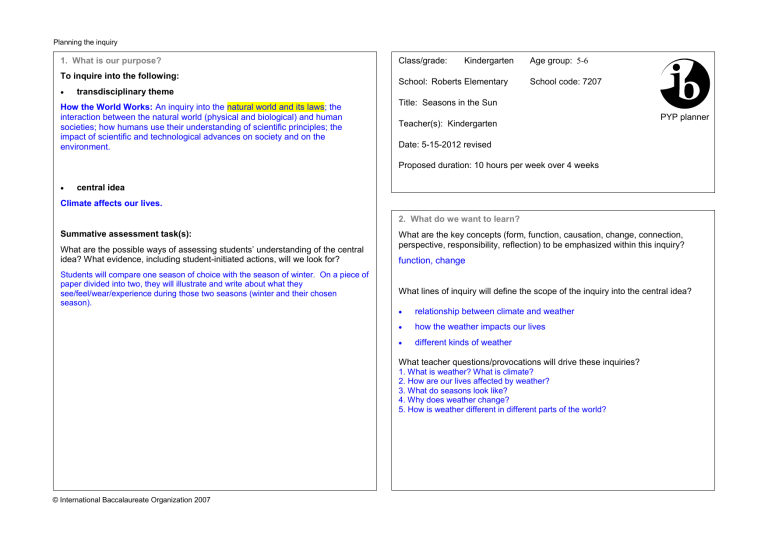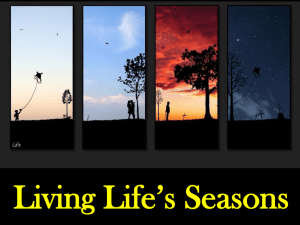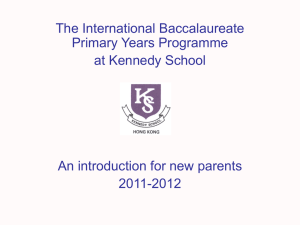PYP planner Planning the inquiry Class/grade: Kindergarten Age

Planning the inquiry
1. What is our purpose?
To inquire into the following:
transdisciplinary theme
How the World Works: An inquiry into the natural world and its laws; the interaction between the natural world (physical and biological) and human societies; how humans use their understanding of scientific principles; the impact of scientific and technological advances on society and on the environment. central idea
Climate affects our lives.
Summative assessment task(s):
What are the possible ways of assessing students’ understanding of the central idea? What evidence, including student-initiated actions, will we look for?
Students will compare one season of choice with the season of winter. On a piece of paper divided into two, they will illustrate and write about what they see/feel/wear/experience during those two seasons (winter and their chosen season).
© International Baccalaureate Organization 2007
Class/grade: Kindergarten Age group: 5-6
School: Roberts Elementary School code: 7207
Title: Seasons in the Sun
Teacher(s): Kindergarten
Date: 5-15-2012 revised
Proposed duration: 10 hours per week over 4 weeks
PYP planner
2. What do we want to learn?
What are the key concepts (form, function, causation, change, connection, perspective, responsibility, reflection) to be emphasized within this inquiry? function, change
What lines of inquiry will define the scope of the inquiry into the central idea?
relationship between climate and weather
how the weather impacts our lives
different kinds of weather
What teacher questions/provocations will drive these inquiries?
1. What is weather? What is climate?
2. How are our lives affected by weather?
3. What do seasons look like?
4. Why does weather change?
5. How is weather different in different parts of the world?
Planning the inquiry
3. How might we know what we have learned?
This column should be used in conjunction with “How best might we learn?”
What are the possible ways of assessing students’ prior knowledge and skills?
What evidence will we look for?
Brainstorm a list of weather words.
Begin a KWL chart with the class to find out what the students already think they know and things that they want to learn during the inquiry. Later, they will complete the chart by adding things they have learned during the unit.
Ask students how we can learn more about weather and climate. What kinds of sources will we access?
What are the possible ways of assessing student learning in the context of the lines of inquiry? What evidence will we look for?
*Children will identify photographs of people and predict the season.
* Children will identify weather terms from pictures.
*Students will write and illustrate in their journal about their favorite season or weather.
* Students will graph the month’s weather on a chart.
5. What resources need to be gathered?
4. How best might we learn?
What are the learning experiences suggested by the teacher and/or students to encourage the students to engage with the inquiries and address the driving questions?
What opportunities will occur for transdisciplinary skills development and for the development of the attributes of the learner profile?
Transdisciplinary Skills are noted in each activity below.
Frontloading –Students explore weather books and pictures of weather related items beginning inquiry.
1. Calendar activities are done on a daily basis. Children graph the weather, take outside temperatures, compare and contrast different types of weather. (T, SM)
2. Teacher will introduce the unit by having children take an imaginary trip and discuss the types of clothing that they will need to bring, based on the weather. Students use a weather map from the newspaper to locate information. (T, R, SM)
3. Teacher leads class with the question, “What is Weather? What is climate?” (T, C)
4. The class will talk about what humans and animals do to adjust and adapt to their environments.(T, R)
5. Teacher and students will bring in news articles and photographs throughout the unit to demonstrate how weather has affected the lives of people around the world (including seasons). (R, S)
6. Discuss why seasons and climates are different throughout the world. Identify the equator on a globe and explain its significance. (R, T, C)
B. Leading/facilitating children’s inquiry
1. Students will make a weather book which illustrates and describes different types of weather. (C, T)
3. Students will create a tornado using soda bottles. Then, the class will discuss how a tornado can affect human lives. (S, R)
4. The teacher will read, It Looked like Spilt Milk and the students will create clouds and describe what their cloud looks like after observing real clouds outside. (C, T)
5. Fingerplays and songs identifying the 4 seasons. (C, S)
6. Science lab experience - Use thermometer to measure hot, cold, and room temperature water; Fill a clear container with water - observe daily changes, such as evaporation; Make a cloud in a jar; make a weather vane. (R, T)
7. Students will complete a worksheet identifying how trees and clothing change with each season. (C, T)
8. Students will complete a daily log using weather symbols at home for 1 month. (SM, R)
What people, places, audio-visual materials, related literature, music, art, computer software, etc, will be available?
Reasons for Seasons by Gibbons; Cloudy with a Chance of Meatballs; It Looked Like Spilt Milk; Apple Tree, Apple Tree; I Know Clouds; Sun and Moon are Friends; Animals in
Winter; The Bernstein Bears Big Book of Nature;
What’s the Weather Like Today (Creative Movement); The Mitten by Brett; The Hat by Brett; Rain Talk; A Letter for Amy by
Keats; Bob the Snowman; Green Eyes; Geraldine’s Big Snow; On a Hot, Hot Day; Sun Up, Sun Down; Time to Sleep
Leveled Reader -What Will the Weather Be Like Today
How will the classroom environment, local environment, and/or the community be used to facilitate the inquiry?
Site based field trip – Snow Day
© International Baccalaureate Organization 2007
Reflecting on the inquiry
6. To what extent did we achieve our purpose?
Assess the outcome of the inquiry by providing evidence of students’ understanding of the central idea. The reflections of all teachers involved in the planning and teaching of the inquiry should be included.
The kids are really into the Arctic and polar regions this year. It is probably due to several movies they have seen. But it has provided a great opportunity for discussion about various climates. H aving an “Arctic Blast” in Houston was a good first hand experience for understanding freezing temperature and water to ice. Being able to see their breath as they breathe out was also a good example of vapor. Using the science experiment with water evaporation in the cup has been also been a good discussion. In technology they have used Kid Pix to draw 2 of the 4 seasons. Using the example from Green Eyes of a kitten experiencing all 4 seasons between birthdays really helped the students understand the rotate of the seasons. We are looking forward to having a meteorologist come and talk with the kids about weather and climate. The United Streaming video on Seasons was also a new addition to this planner.
How you could improve on the assessment task(s) so that you would have a more accurate picture of each student’s understanding of the central idea.
We could talk more about comparing seasons in different parts of the world.
We could talk more about how people’s lives are affected in different parts of the world due to extreme weather conditions and location on the globe.
What was the evidence that connections were made between the central idea and the transdisciplinary theme?
(Research) Students are looking at weather forecasts to know what future weather will be.
(Self-Management) Students are self-managing as they choose appropriate clothing according to the weather.
(Communication) Students are talking with peers about their personal experiences during different seasons.
© International Baccalaureate Organization 2007
7. To what extent did we include the elements of the PYP?
What were the learning experiences that enabled students to:
develop an understanding of the concepts identified in “What do we want to learn?”
Function – Through experiments, students learn about evaporation, rain, and tornados. Through daily research (weather forecasting) students will learn about types of weather and weather trends.
Change – Students will observe and discuss changes in trees, temperature, and weather, etc. as the seasons change. They will discuss and write/illustrate about such topics as hours of sunlight per day during different seasons, appearance of clouds before a storm, clothing that is worn in different seasons/climates/parts of the world.
demonstrate the learning and application of particular transdisciplinary skills?
This unit allows students to develop in each of the five transdisciplinary skills.
They are immersed in discussion about several weather/climate topics. They self-manage as they: choose their clothing for the weather, participate in calendar activities. They are thinking as they make predictions before experiments and as they debrief about their learning. They research as they look through books, search the newspaper for weather forecasts, etc.
develop particular attributes of the learner profile and/or attitudes? In each case, explain your selection.
Enthusiasm – Snow day and experiment excitement
Communication
– Sharing worldly climate presentations
Curiosity – Lots of interest in storms
Independence
– Dressing self according to weather predictions
Reflecting on the inquiry
8. What student-initiated inquiries arose from the learning?
Record a range of student-initiated inquiries and student questions and highlight any that were incorporated into the teaching and learning.
1. Does thunder come in the winter time?
2. Why do bears hibernate?
3. Do you think animals like winter?
4. Where does rain come from?
5. Can lightning strike?
6. What makes the water in our classroom evaporate?
At this point teachers should go back to box 2 “What do we want to learn?” and highlight the teacher questions/provocations that were most effective in driving the inquiries.
What student-initiated actions arose from the learning?
Record student-initiated actions taken by individuals or groups showing their ability to reflect, to choose and to act.
The kids were much better about wearing clothing appropriate for the climate
“If I had $100 I would buy toys for the children who lost their toys in the tsunami.”
A student made a model of the tsunami and the earthquake to share with the class.
A student was very excited about moving to Holland because he was happy about being closer to the North Pole.
A student brought a bikini for Show&Tell, after her trip to Brazil.
© International Baccalaureate Organization 2007
9. Teacher notes







